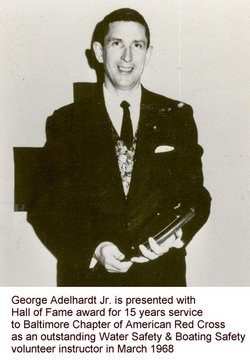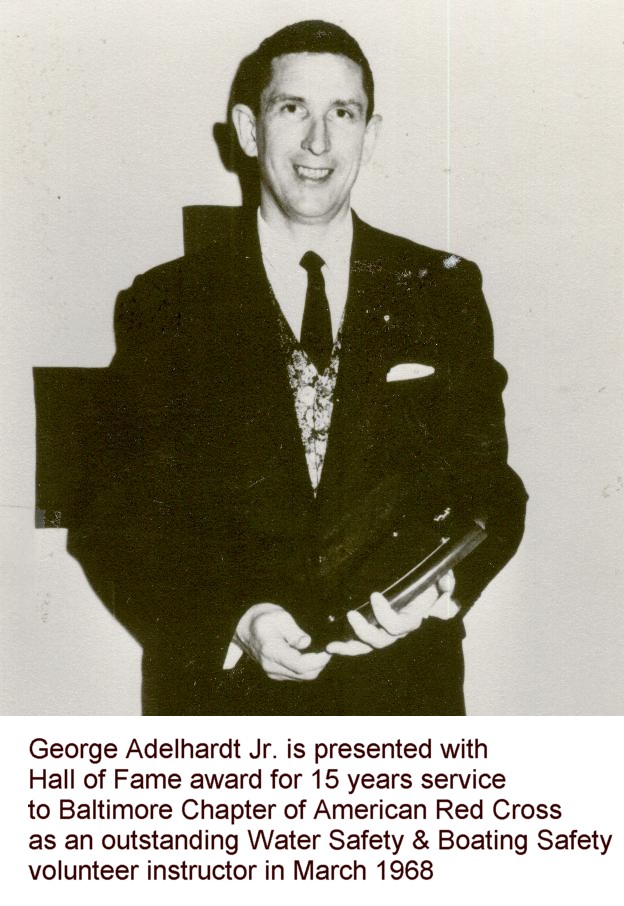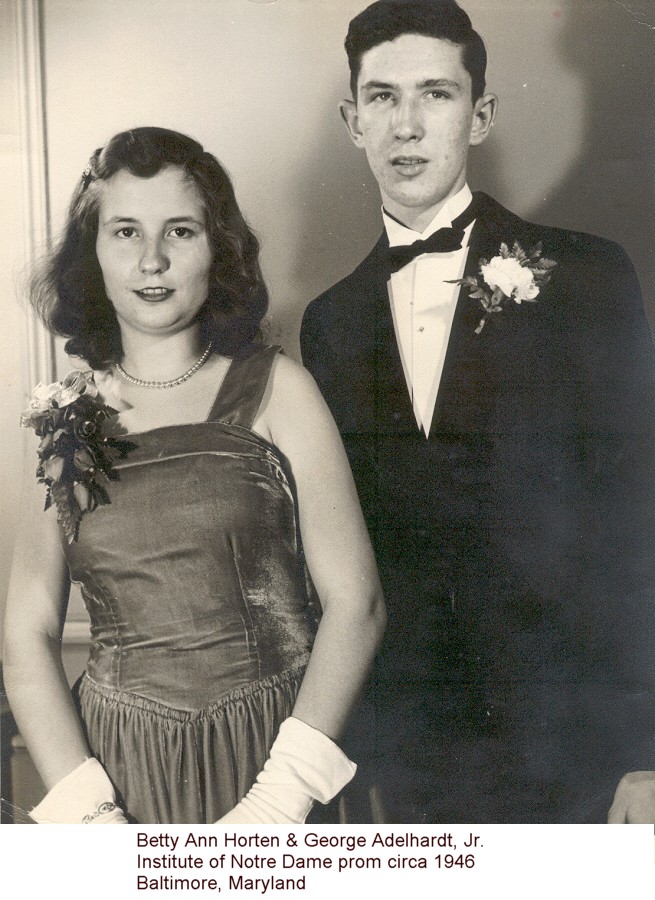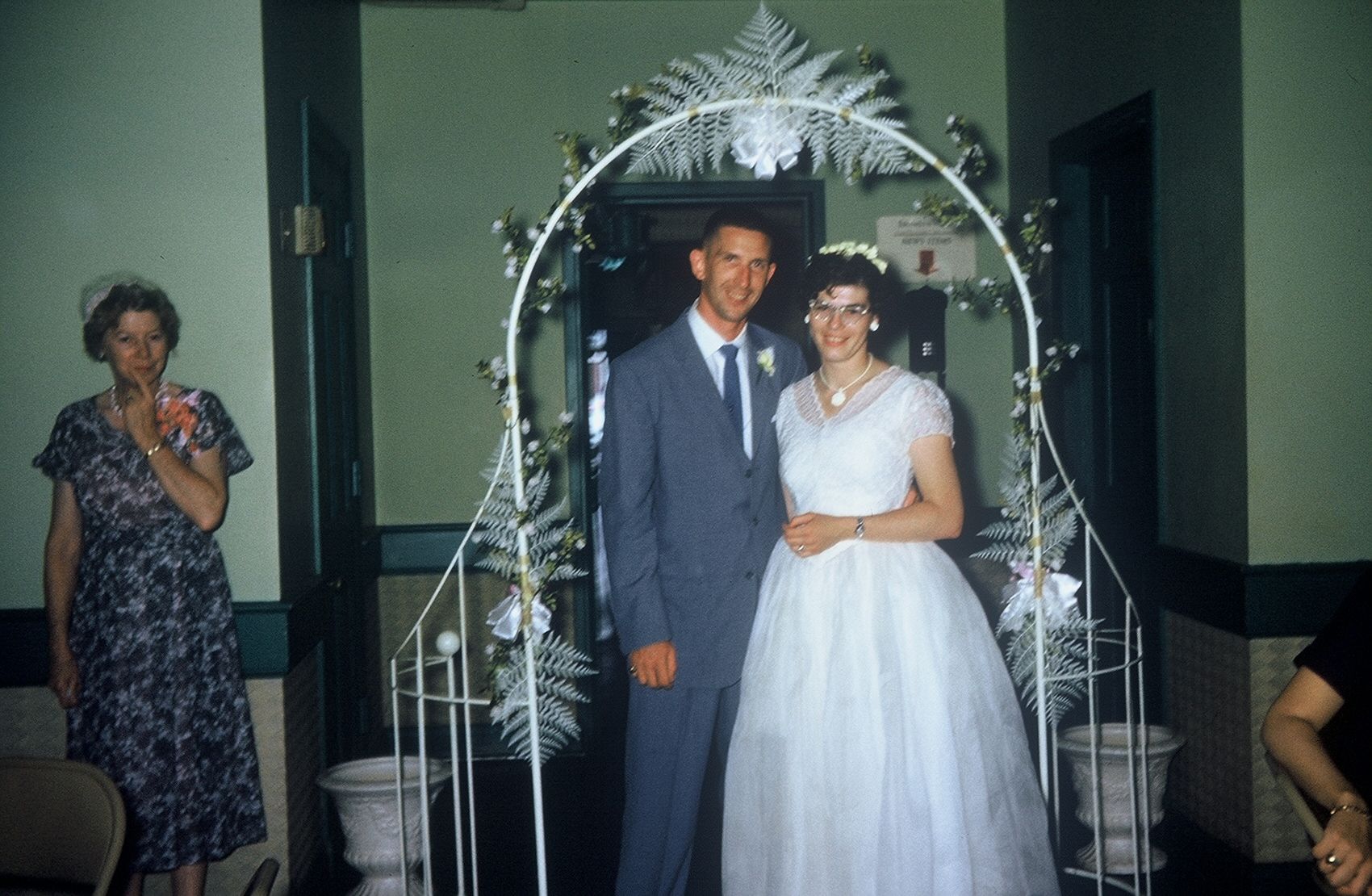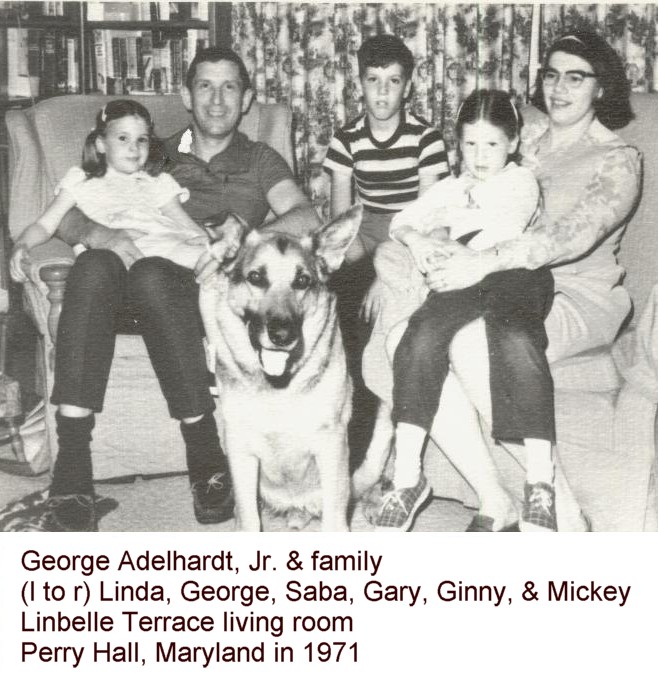George Jr. graduated from the Mount Saint Joseph high school in 1947. Also in 1947, the Adelhardt family purchased a home at 5104 Richard Avenue just off of Harford Road and moved out to the Hamilton neighborhood of Northeast Baltimore. Junie did volunteer work with youth in the Boy Scouts of America and the YMCA Baltimore Branch. He was a warrant officer in the Civil Air Patrol, socially belonged to the Grachur Club, the National Geographic Society and the American Radio Relay League as he was a short wave radio enthusiast. He first worked as a radio repairer for the U.S. Army Signal Depot.
George, Jr. was drafted into the U.S. Army during the Korean War on July 11, 1951. Private First Class Adelhardt received basic training at Fort Meade in Anne Arundel County and then was transferred to Ft. Monmouth, New Jersey (where he graduated from Signal Corp School until eventually he was stationed at Sandia Army Base in Albuquerque, New Mexico where he receive a top secret security clearance from the Atomic Energy Commission. While the Cold War and the radiation fallout debate raged during the mid-1950s, the U.S. nuclear weapons testing program continued to escalate. American servicemen and civilians were, more than ever, in the radioactive line of fire in places like Alamogordo, Carlsbad, and Farmington, New Mexico. The government gave scant priority to the health and safety of its own citizens. At the Nevada Nuclear Test Site atmospheric nuclear bomb tests continued until mid-1962. Leukemia and cancer deaths rose noticeably as mushroom clouds continued to darken the horizon. This may have contributed to George's health problems later in life. Towards the end of his two-year service he broke his arm and was assigned to teach swimming to the officer's children. Barb and George and Carlita flew out to New Mexico when he was discharged and Junie drove them back across the Southern states in his car. This was the family's first trip in an airplane.
Once home in Baltimore, George worked at the Aberdeen Proving Ground in Harford County at the Air Flow Branch Ballistics Research Lab. In the summers he worked as a camp counselor at the Broad Creek Scout Camps in Baltimore. He later got a classified engineering job working in the electrical testing division of the Bendix Corporation. He also attended the McCoy College of Continuing Education of the Johns Hopkins University in the evenings. In what little spare time he had left he volunteered as an instructor of swimming and lifesaving and also gave lessons in canoeing for the American Red Cross. It was here that he met his future wife Cecelia Quinby better known as Mickey. After dating for several years, they were married on July 11, 1959 at St. Lawrence Catholic Church. (Mickey's grandfather had attended Mass in the barn that eventually had become St. Lawrence Church) George and Mickey first lived in an apartment at 2008 Lyndonlea Way near Belvedere Avenue and Hillen Road in Northeast Baltimore. They had their first child Gary in 1961 and in 1963 moved into a large home at 3508 Linbelle Terrace near Perry Hall in Baltimore County northeast of the city. They had an expansive yard and he was able to store a station wagon, camper, rowboat, and canoe in his large unattached garage. Their home sat on a hill with views of the rural surroundings of the area and as far as the Bay Bridge. They expanded their family a few years later with two younger daughters - Virginia in 1966 (whom they called Ginny) and Linda in 1967. Gary was given the attic bedroom and the girls shared one of the downstairs bedrooms. Particular mention should be made of their large dog companion Saba, a gentle and well- disciplined (the Junie school of obedience) German shepherd who was with the Adelhardts for eleven years. Mickey worked as a nurse at the Bon Secour Hospital in southwest Baltimore. Later she began to work as a registered nurse for the American Red Cross Blood Services. After ten years of hard work and study George graduated from Johns Hopkins University in 1965.
In April 1972, George discovered that he had leukemia. The doctors sadly tried many kinds of therapies on him including collecting blood platelets from his sister Carlita in order to replace his own. Later chemotherapy wreaked havoc on his body with loss of hair and such weakness that he had to use a wheel chair. After only 4 1/2 months of frequent hospital visits, George died on September 1, 1972 at the young age of 42. At the same time, his wife Mickey discovered that she had multiple pre-cancerous breast tumors which resulted in a mastectomy two days before George died and another two years later. George, Jr was a remarkable man. He accepted his diagnosis calmly and helped the rest of his family deal with his illness and his dying process. George, Sr. and Barbara were devastated to see first their son and years later their daughter die before them. His funeral Mass was held at St. Joseph's Catholic Church at Fullerton – a newly constructed church decorated with carpeted floors and modern sculpture and art. The church's use of folk music also reflected how it embraced the progressive changes and style of Vatican II Catholicism. He was buried as a veteran at Gettysburg National Cemetery, one of the last graves available at this cemetery even in the Annex section.
Mickey remained strong and continued to support her children and mother despite her difficulties with back pain and surgery. On Christmas Day 1977, George and Barbara and the entire Adelhardt family gathered one last time at the house in Perry Hall. At the beginning of 1978 Mickey, her mother Mary Quinby, Gary, Ginny, and Linda moved to Bountiful, Utah. Mickey continued her Red Cross Blood Services work in the Intermountain region based in Utah.
George Jr. graduated from the Mount Saint Joseph high school in 1947. Also in 1947, the Adelhardt family purchased a home at 5104 Richard Avenue just off of Harford Road and moved out to the Hamilton neighborhood of Northeast Baltimore. Junie did volunteer work with youth in the Boy Scouts of America and the YMCA Baltimore Branch. He was a warrant officer in the Civil Air Patrol, socially belonged to the Grachur Club, the National Geographic Society and the American Radio Relay League as he was a short wave radio enthusiast. He first worked as a radio repairer for the U.S. Army Signal Depot.
George, Jr. was drafted into the U.S. Army during the Korean War on July 11, 1951. Private First Class Adelhardt received basic training at Fort Meade in Anne Arundel County and then was transferred to Ft. Monmouth, New Jersey (where he graduated from Signal Corp School until eventually he was stationed at Sandia Army Base in Albuquerque, New Mexico where he receive a top secret security clearance from the Atomic Energy Commission. While the Cold War and the radiation fallout debate raged during the mid-1950s, the U.S. nuclear weapons testing program continued to escalate. American servicemen and civilians were, more than ever, in the radioactive line of fire in places like Alamogordo, Carlsbad, and Farmington, New Mexico. The government gave scant priority to the health and safety of its own citizens. At the Nevada Nuclear Test Site atmospheric nuclear bomb tests continued until mid-1962. Leukemia and cancer deaths rose noticeably as mushroom clouds continued to darken the horizon. This may have contributed to George's health problems later in life. Towards the end of his two-year service he broke his arm and was assigned to teach swimming to the officer's children. Barb and George and Carlita flew out to New Mexico when he was discharged and Junie drove them back across the Southern states in his car. This was the family's first trip in an airplane.
Once home in Baltimore, George worked at the Aberdeen Proving Ground in Harford County at the Air Flow Branch Ballistics Research Lab. In the summers he worked as a camp counselor at the Broad Creek Scout Camps in Baltimore. He later got a classified engineering job working in the electrical testing division of the Bendix Corporation. He also attended the McCoy College of Continuing Education of the Johns Hopkins University in the evenings. In what little spare time he had left he volunteered as an instructor of swimming and lifesaving and also gave lessons in canoeing for the American Red Cross. It was here that he met his future wife Cecelia Quinby better known as Mickey. After dating for several years, they were married on July 11, 1959 at St. Lawrence Catholic Church. (Mickey's grandfather had attended Mass in the barn that eventually had become St. Lawrence Church) George and Mickey first lived in an apartment at 2008 Lyndonlea Way near Belvedere Avenue and Hillen Road in Northeast Baltimore. They had their first child Gary in 1961 and in 1963 moved into a large home at 3508 Linbelle Terrace near Perry Hall in Baltimore County northeast of the city. They had an expansive yard and he was able to store a station wagon, camper, rowboat, and canoe in his large unattached garage. Their home sat on a hill with views of the rural surroundings of the area and as far as the Bay Bridge. They expanded their family a few years later with two younger daughters - Virginia in 1966 (whom they called Ginny) and Linda in 1967. Gary was given the attic bedroom and the girls shared one of the downstairs bedrooms. Particular mention should be made of their large dog companion Saba, a gentle and well- disciplined (the Junie school of obedience) German shepherd who was with the Adelhardts for eleven years. Mickey worked as a nurse at the Bon Secour Hospital in southwest Baltimore. Later she began to work as a registered nurse for the American Red Cross Blood Services. After ten years of hard work and study George graduated from Johns Hopkins University in 1965.
In April 1972, George discovered that he had leukemia. The doctors sadly tried many kinds of therapies on him including collecting blood platelets from his sister Carlita in order to replace his own. Later chemotherapy wreaked havoc on his body with loss of hair and such weakness that he had to use a wheel chair. After only 4 1/2 months of frequent hospital visits, George died on September 1, 1972 at the young age of 42. At the same time, his wife Mickey discovered that she had multiple pre-cancerous breast tumors which resulted in a mastectomy two days before George died and another two years later. George, Jr was a remarkable man. He accepted his diagnosis calmly and helped the rest of his family deal with his illness and his dying process. George, Sr. and Barbara were devastated to see first their son and years later their daughter die before them. His funeral Mass was held at St. Joseph's Catholic Church at Fullerton – a newly constructed church decorated with carpeted floors and modern sculpture and art. The church's use of folk music also reflected how it embraced the progressive changes and style of Vatican II Catholicism. He was buried as a veteran at Gettysburg National Cemetery, one of the last graves available at this cemetery even in the Annex section.
Mickey remained strong and continued to support her children and mother despite her difficulties with back pain and surgery. On Christmas Day 1977, George and Barbara and the entire Adelhardt family gathered one last time at the house in Perry Hall. At the beginning of 1978 Mickey, her mother Mary Quinby, Gary, Ginny, and Linda moved to Bountiful, Utah. Mickey continued her Red Cross Blood Services work in the Intermountain region based in Utah.
Inscription
Maryland
PFC HQ CO 8452 AAU SANDIA BASE NM ARTY
US Army
Korea
Family Members
Sponsored by Ancestry
Advertisement
Records on Ancestry
Advertisement
